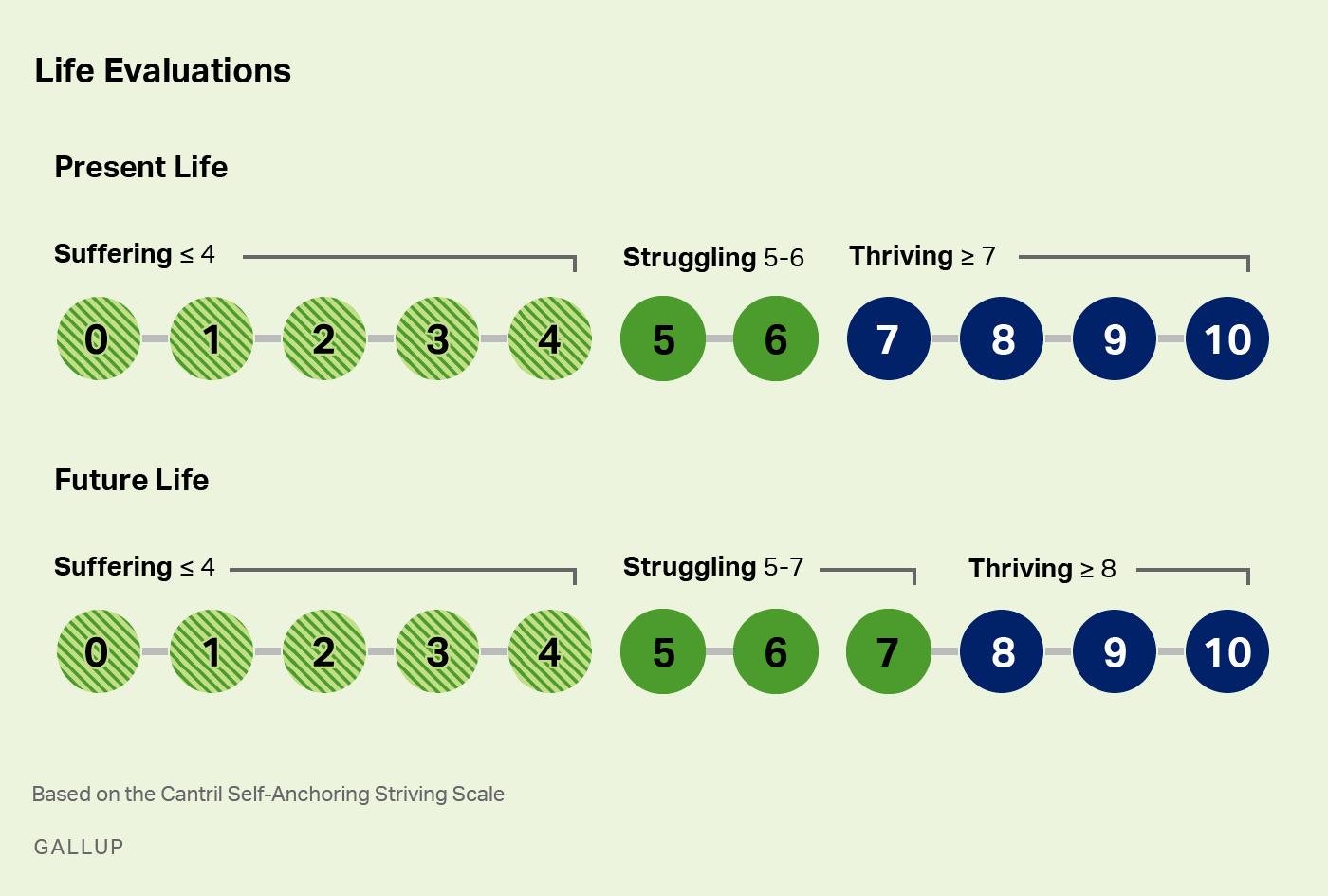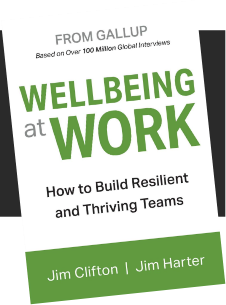
What Is Employee Wellbeing? And Why Does It Matter?
- What Is Wellbeing?
- How Is the Quality of Life Measured?
- The Elements of Wellbeing
- Should Employers Be Responsible for the Wellbeing of Their Workers?
- How Does Wellbeing Affect Employee Attraction and Retention?
- How Does Wellbeing Affect Employee Engagement?
- Why Should Employers Invest in Employee Wellbeing?
- Creating an Employee Wellbeing Strategy With Gallup
01 What Is Wellbeing?
It's common to think of wellbeing as solely related to physical health, but any complete wellbeing definition must capture so much more.
Wellbeing includes the major components of a great life -- an individual's experiences and perceptions of what's important. Ultimately, it represents how someone's life is going. But wellbeing is not the same as wellness, which is a component of employee wellbeing.

Gallup has discovered five core elements of wellbeing:
- Career
- Social
- Financial
- Physical
- Community
Stressed-out and burned-out employees often inspire leaders to ask, "What does wellbeing mean?"
Fortunately, employee wellbeing is quantifiable, meaning that you can define wellbeing, measure it, understand it and transform it within an organization.
Learn how Gallup can transform wellbeing and create resiliency in your organization.
02 How Is the Quality of Life Measured?
Measuring the quality of life has traditionally been done with indicators like a country's gross domestic product or a family's household income. These are certainly still important metrics.
But they don't capture the whole picture of how someone's life is going. To get a more complete picture, Gallup uses many measurements, like the Positive Emotions Index and the Negative Emotions Index, which track the kinds of emotional experiences people have on a daily basis.
The most powerful method we use for measuring wellbeing and Gallup Net Thriving is the Life Evaluation Index, which asks people to rate their lives now and what they think their lives will be like in the future.
The Life Evaluation Index question reads: "Please imagine a ladder with steps numbered from zero at the bottom to 10 at the top. The top of the ladder represents the best possible life for you and the bottom of the ladder represents the worst possible life for you.
Q1: On which step of the ladder would you say you personally feel you stand at this time? (0-10)
Q2: On which step do you think you will stand about five years from now? (0-10)
This index reveals what someone thinks of their life now and how they see their future.
Based on their responses to these questions, Gallup categorizes people into three groups:
Using this simple two-part question, organizations can discover what percentage of their employees are thriving, struggling and suffering, thus measuring their quality of life.

03 The Elements of Wellbeing
Gallup conducted decades-long global studies of wellbeing, looking for facets of life that transcend culture and region.
Through these studies, Gallup has discovered five universal elements of wellbeing. These are distinct facets of life that separate a thriving individual from one who is struggling or suffering.
Each element represents a part of life that people can do something about:

Career wellbeing action items for leaders:




How does mental wellbeing factor in?
We don't want to leave employees' mental health out of the conversation. Mental health should be on every organization's radar, especially now, during a mental health crisis.

Gallup's five elements of wellbeing predict whether employees suffer, struggle or thrive, while also predicting daily emotions. We partner with organizations to reduce mental health factors like stress and worry through the development of organizational culture.
"Gallup's most recent global analytics concluded that a good job, with engaging work, is the very foundation of a thriving life."

Explore Gallup's book Wellbeing at Work to discover how organizations can create a resilient, thriving workforce.
04 Should Employers Be Responsible for the Wellbeing of Their Workers?
Faced with the proposition of improving workplace wellbeing, many employers understandably ask whether it's their position to influence employee wellbeing in the first place.
Simply put: Creating thriving lives is the right thing to do, and it makes good business sense too. Here are a few reasons why:

Work and life aren't mutually exclusive. Gallup's research shows that work influences home life, and home life influences work. It's in an employer's best interest for workers to have a thriving life and bring the effect of that thriving life to work.

The more elements of wellbeing an employee thrives in, the better. The five elements of wellbeing are additive, which means that such things as disease burden, burnout, anxiety and associated costs drop with each element an employee thrives in. Thriving in physical wellbeing alone is less valuable than thriving in all five areas.

You can transform wellbeing. While modern research suggests that genetics determine about half of wellbeing, individual choice affects a wide variation around the genetic baseline.
Many organizations are satisfied to provide wellness programs, but to realize benefits beyond those associated with physical health, organizations need the more holistic approach of taking care of the whole person, not just the employee.
The benefits of improving wellbeing have serious implications for business outcomes. For example, teams that believe their organization cares about their wellbeing perform better on a number of metrics, including customer engagement, profitability and productivity, turnover, and safety incidents.
05 How Does Wellbeing Affect Employee Attraction and Retention?
High wellbeing in the workplace is a retention booster and a talent magnet.
Employee Retention
With higher life evaluation among employees, risk of turnover lessens. The difference in turnover rates between thriving employees and those who are struggling or suffering is considerable. When employees are thriving, they're 32% less likely to be watching for or actively seeking another job.
To keep your most talented employees, you must help them live thriving lives. Begin by engaging employees, which builds the foundations of career and social wellbeing.

Employee engagement opens the door for employee wellbeing. The elements of engagement create trust and address workplace factors like having clear employee expectations and the right materials and equipment, recognition at work, developmental opportunities, and a motivating purpose.
The trust created through the satisfaction of these workplace needs forges a pathway for having meaningful discussions about wellbeing with employees.

Employee Attraction
Word spreads about whether wellbeing is a priority for your organization, which affects your employment brand and your ability to attract top-tier talent.
24% Only 24% of U.S. employees strongly agree that their organization cares about their overall wellbeing.
When looking for a job, many employees seek employment that contributes to their wellbeing and helps them create work-life balance.
For job seekers, the importance of wellbeing and work-life balance has become particularly important. In fact, 59% of U.S. workers say that having greater work-life balance and better personal wellbeing is very important to them when considering whether to take a job with a different organization.
Leaders who wish to attract and retain star talent, especially in a tight labor market, should prioritize wellbeing and take steps to create a net thriving culture.
06 How Does Wellbeing Affect Employee Engagement?
Employee engagement and wellbeing are connected in two distinct ways:

On its own, employee engagement makes a considerable improvement to business outcomes. Combined with thriving employees, these improvements become even more potent.
Productivity increases and burnout drops, for example, when workers are engaged and thriving in the workplace. And in the absence of wellbeing, even if employees are engaged, risk to your employees and your organization increases.
Indeed, comparing employees who are engaged but not thriving with those who are engaged and thriving, those who aren't thriving report the following risks:
Employee engagement and wellbeing, when brought together, create a high-performance employee environment in which the two inform and build on one another.
07 Why Should Employers Invest in Employee Wellbeing?
Modern employees expect employers to help them live great lives. But improving employee wellbeing isn't just an exercise in altruism.
Employers who care for employee health and wellbeing see numerous measurable benefits, from higher productivity and profitability to lower turnover and fewer safety incidents.
Well-designed and research-informed wellbeing initiatives and strategies provide all-important organizational resilience and remove risk from organizations.

Teams that believe their organization cares about their wellbeing perform better too, reaching higher customer engagement, profitability and productivity with lower turnover and fewer safety incidents.
The business case for improving employee health and wellbeing is compelling, as is the resiliency that is created through employee wellbeing.
Every organization needs more resilient employees -- something that sudden and major disruptions reveal.
08 Creating an Employee Wellbeing Strategy With Gallup

Partner with Gallup to create a thriving organization.
It's time to reimagine your employee wellbeing initiatives. Contact us to learn how to understand your wellbeing needs, prioritize interventions and create meaningful change within your organization. Inform your employee wellbeing strategy with Gallup's advanced global research and advice.